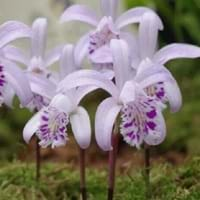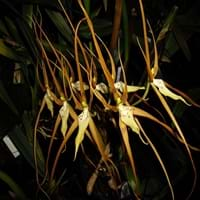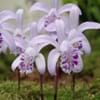Life Span
Perennial
Annual
Origin
China, India, Nepal
Central America
Types
Pleione chunii , Pleione limprichtii
Brassia allenii, Brassia caudata, Brassia cochleata
Habitat
Hilly upland habitat, Wooded hillsides
Coastal Regions
USDA Hardiness Zone
13-15
11-15
Sunset Zone
Not Available
H2
Habit
Clump-Forming
Clump-Forming
Flower Color
White, Yellow, Yellow green, Brown
Light Yellow, Yellow green, Gold, Plum, Sienna
Flower Color Modifier
Bicolor
Multi-Color
Fruit Color
Non Fruiting Plant
Brown, Light Green
Leaf Color in Spring
Light Green
Green
Leaf Color in Summer
Light Green, Yellow green
Green
Leaf Color in Fall
Light Green
Green
Leaf Color in Winter
Not Available
Green
Leaf Shape
Elliptic to oblong
Needle like
Plant Season
Spring, Winter
Summer, Fall
Sunlight
Partial shade, Full Shade
Partial Sun, Partial shade
Type of Soil
Not Available
Not Available
The pH of Soil
Not Available
Not Available
Soil Drainage
Well drained
Well drained
Bloom Time
Early Spring, Winter, Late Winter
Early Fall, Fall, Late Fall, Early Winter
Tolerances
Light Frost
Not Available
Where to Plant?
Ground, Pot
Container, Ground, Pot
How to Plant?
Bulbs
Divison
Plant Maintenance
Medium
Medium
Watering Requirements
Do not water excessively, Needs very little water
Needs very little water
In Summer
Lots of watering
Lots of watering
In Spring
Moderate
Moderate
In Winter
Average Water
Average Water
Soil pH
Not Available
Not Available
Soil Type
Not Available
Not Available
Soil Drainage Capacity
Well drained
Well drained
Sun Exposure
Partial shade, Full Shade
Partial Sun, Partial shade
Pruning
Prune if you want to improve plant shape, Remove damaged leaves, Remove dead branches, Remove dead leaves
No pruning needed
Fertilizers
All-Purpose Liquid Fertilizer, Compost
Occasional light liquid fertilizer
Pests and Diseases
Free of serious pests and diseases
Red blotch
Plant Tolerance
Light Frost
Not Available
Flower Petal Number
Single
Single
Foliage Texture
Medium
Coarse
Foliage Sheen
Matte
Matte
Attracts
Birds, Bumblebees, Butterflies, Hummingbirds, Not Available
Not Available
Allergy
Unknown
Not Available
Aesthetic Uses
Bonsai, Showy Purposes
Showy Purposes
Beauty Benefits
Not Available
Not Available
Environmental Uses
Air purification
Air purification
Medicinal Uses
No Medicinal Use
Not Available
Part of Plant Used
Not Available
Flowers, Fruits, Leaves
Other Uses
Acts as a natural source of rain water for birds and insects., Beneficial species for attracting pollinators
Showy Purposes
Used As Indoor Plant
No
Yes
Used As Outdoor Plant
Yes
Yes
Garden Design
Container, Hanging Basket, Houseplant, Tropical
Container, Cutflower, Feature Plant, Hanging Basket, Houseplant, Tropical
Botanical Name
SIGMATOSTALIX amazonica
BRASSIA arcuigera
Common Name
Amazon Sigmatostalix Orchid, Miniature Orchid
Arching Brassia, Arching Spider Orchid, Orchid
In Hindi
miniature orchid
Arching Brassia plant
In German
miniature orchid
Arching Brassia Pflanze
In French
Pleione
plante Arching Brassia
In Spanish
Pleione
planta de arqueo Brassia
In Greek
Pleione
φυτό κύρτωση Brassia
In Portuguese
miniature orchid
planta arqueamento Brassia
In Polish
miniature orchid
Wyginając Brassia roślin
In Latin
miniature orchid
Curva Brassia herba
Phylum
Magnoliophyta
Magnoliophyta
Class
Liliopsida
Liliopsida
Order
Asparagales
Asparagales
Family
Orchidaceae
Orchidaceae
Clade
Angiosperms, Monocots
Angiosperms, Monocots
Tribe
Coelogyneae
Cymbidieae
Subfamily
Epidendroideae
Epidendroideae
Number of Species
Not Available
Not Available
Properties of Miniature Orchid and Arching Brassia
Wondering what are the properties of Miniature Orchid and Arching Brassia? We provide you with everything About Miniature Orchid and Arching Brassia. Miniature Orchid doesn't have thorns and Arching Brassia doesn't have thorns. Also Miniature Orchid does not have fragrant flowers. Miniature Orchid has allergic reactions like Unknown and Arching Brassia has allergic reactions like Unknown. Compare all the properties and characteristics of these two plants. Find out which of these plant can be used as indoor plant. If you are interested to decorate your house and garden, find out aesthetic uses, compare them and select the plant which will beautify your surrounding. Along with beautification, try comparing medicinal and edible uses of Miniature Orchid and Arching Brassia and you can choose the plant having best and most benefits.
Season and Care of Miniature Orchid and Arching Brassia
Season and care of Miniature Orchid and Arching Brassia is important to know. While considering everything about Miniature Orchid and Arching Brassia Care, growing season is an essential factor. Miniature Orchid season is Spring and Winter and Arching Brassia season is Spring and Winter. The type of soil for Miniature Orchid is Not Available and for Arching Brassia is Not Available while the PH of soil for Miniature Orchid is Not Available and for Arching Brassia is Not Available.
Miniature Orchid and Arching Brassia Physical Information
Miniature Orchid and Arching Brassia physical information is very important for comparison. Miniature Orchid height is 12.70 cm and width 15.20 cm whereas Arching Brassia height is 50.80 cm and width 66.04 cm. The color specification of Miniature Orchid and Arching Brassia are as follows:
Miniature Orchid flower color: White, Yellow, Yellow green and Brown
Miniature Orchid leaf color: Light Green
Arching Brassia flower color: Light Yellow, Yellow green, Gold, Plum and Sienna
- Arching Brassia leaf color: Green
Care of Miniature Orchid and Arching Brassia
Care of Miniature Orchid and Arching Brassia include pruning, fertilizers, watering etc. Miniature Orchid pruning is done Prune if you want to improve plant shape, Remove damaged leaves, Remove dead branches and Remove dead leaves and Arching Brassia pruning is done No pruning needed. In summer Miniature Orchid needs Lots of watering and in winter, it needs Average Water. Whereas, in summer Arching Brassia needs Lots of watering and in winter, it needs Average Water.



